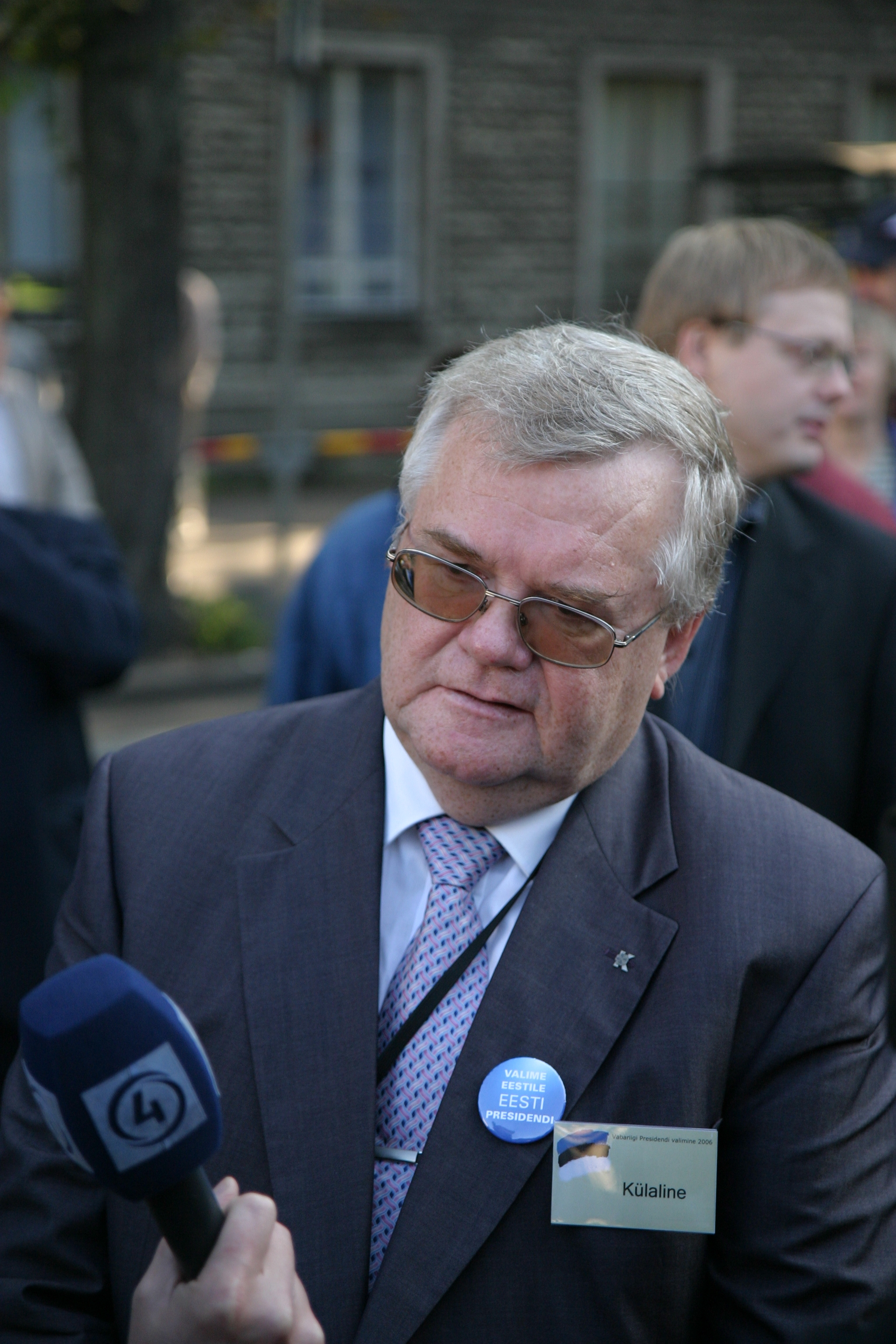|
Edgar Savisaar
Edgar Savisaar (31 May 1950 – 29 December 2022) was an Estonian politician, one of the founding members of Popular Front of Estonia and the Estonian Centre Party, Centre Party. He served as the Prime Minister of Estonia, acting Prime Minister of Estonia, Minister of the Interior (Estonia), Minister of the Interior, Ministry of Economic Affairs and Communications, Minister of Economic Affairs and Communications, and twice mayor of Tallinn. Early life and education Savisaar was born in the Harku Prison in 1950. His parents Elmar Savisaar (1911–1970) and Marie Savisaar née Burešin (1912–1984) were farmers from Vastse-Kuuste, Tartu County, who both had been convicted in 1949 of resisting Collectivization in the Soviet Union, collectivization. The events, which had culminated with physical conflict, had started when kolhoz activists came to Nationalization, nationalise Savisaar couple's two cows (named Marja and Oksa), a pig, a horse drawn hay rake, a spring-tooth harrow, an ... [...More Info...] [...Related Items...] OR: [Wikipedia] [Google] [Baidu] |
Prime Minister Of Estonia
The prime minister of Estonia () is the head of government of the Estonia, Republic of Estonia. The prime minister is nominated by the President of Estonia, president after appropriate consultations with the parliamentary factions and confirmed by the parliament (''Riigikogu''). In case of disagreement, the parliament can reject the president's nomination and choose their own candidate. In practice, since the prime minister must maintain the confidence of parliament in order to remain in office, he or she is usually the leader of the senior partner in the governing coalition. The current prime minister is Kristen Michal of the Estonian Reform Party, Reform Party. He took the office on 23 July 2024 following the resignation of Kaja Kallas. The prime minister does not head any specific ministry. Rather, in accordance with the Constitution of Estonia, constitution, the prime minister supervises the work of the government. The prime minister's significance and role in the government ... [...More Info...] [...Related Items...] OR: [Wikipedia] [Google] [Baidu] |
Popular Front Of Estonia
The Popular Front of Estonia (; RR), introduced to the public by the Estonian politician Edgar Savisaar under the short-lived name Popular Front for the Support of Perestroika, was a political organisation in Estonia in the late 1980s and early 1990s. Edgar Savisaar introduced the idea of popular front during a TV show on 13 April 1988. The idea was developed through the year and finally The Estonian Popular Front was established on 1 October 1988 with a massively crowded congress which turned to a culmination of the first phase of the Singing Revolution. It was to a significant degree the precursor to the current Estonian Centre Party, although with a much broader base of popularity at the beginning. History The Popular Front of Estonia was a major force in the Estonian independence movement that led to the re-establishment of the Republic of Estonia as a country independent from the Soviet Union. It was similar to the Popular Front of Latvia and the Sąjūdis movement i ... [...More Info...] [...Related Items...] OR: [Wikipedia] [Google] [Baidu] |
Nationalization
Nationalization (nationalisation in British English) is the process of transforming privately owned assets into public assets by bringing them under the public ownership of a national government or state. Nationalization contrasts with privatization and with demutualization. When previously nationalized assets are privatized and subsequently returned to public ownership at a later stage, they are said to have undergone renationalization (or deprivatization). Industries often subject to nationalization include telecommunications, electric power, fossil fuels, railways, airlines, iron ore, media, postal services, banks, and water (sometimes called the commanding heights of the economy), and in many jurisdictions such entities have no history of private ownership. Nationalization may occur with or without financial compensation to the former owners. Nationalization is distinguished from property redistribution in that the government retains control of nationalized pro ... [...More Info...] [...Related Items...] OR: [Wikipedia] [Google] [Baidu] |
Kolhoz
A kolkhoz ( rus, колхо́з, a=ru-kolkhoz.ogg, p=kɐlˈxos) was a form of collective farm in the Soviet Union. Kolkhozes existed along with state farms or sovkhoz. These were the two components of the socialized farm sector that began to emerge in Soviet agriculture after the October Revolution of 1917, as an antithesis both to the feudal structure of impoverished serfdom and aristocratic landlords and to individual or family farming. Initially, a collective farm resembled an updated version of the traditional Russian obshchina "commune", the generic "farming association" (''zemledel’cheskaya artel’''), the Association for Joint Cultivation of Land (TOZ), and finally the kolkhoz. This gradual shift to collective farming in the first 11 years after the October Revolution was turned into a "violent stampede" during the forced collectivization campaign that began in 1928. Name The portmanteau is a contraction of . This Russian term was adopted into other languages as ... [...More Info...] [...Related Items...] OR: [Wikipedia] [Google] [Baidu] |
Collectivization In The Soviet Union
The Soviet Union introduced collectivization () of its agricultural sector between 1928 and 1940. It began during and was part of the first five-year plan. The policy aimed to integrate individual landholdings and labour into nominally collectively-controlled and openly or directly state-controlled farms: ''Kolkhozes'' and '' Sovkhozes'' accordingly. The Soviet leadership confidently expected that the replacement of individual peasant farms by collective ones would immediately increase the food supply for the urban population, the supply of raw materials for the processing industry, and agricultural exports via state-imposed quotas on individuals working on collective farms. Planners regarded collectivization as the solution to the crisis of agricultural distribution (mainly in grain deliveries) that had developed from 1927. This problem became more acute as the Soviet Union pressed ahead with its ambitious industrialization program, meaning that more food would be needed ... [...More Info...] [...Related Items...] OR: [Wikipedia] [Google] [Baidu] |
Tartu County
Tartu County ( or ''Tartumaa'') is one of 15 counties of Estonia. It is located in eastern Estonia bordering Põlva County, Valga County, Viljandi County and Jõgeva County. The area of Tartu County is , which covers 6.9% of the territory of Estonia. In 2022 Tartu County had a population of 157,758 – constituting 11.9% of the total population in Estonia. The city of Tartu is the centre of the county located at a distance of from Tallinn. Tartu County is divided into 8 local governments – 1 urban and 7 rural municipalities. Geography Tartu County lies in South Estonia, between Lake Võrtsjärv and Lake Peipus. Estonia's only navigable river, River Emajõgi (100 km long), flows through the county, connecting Lake Peipus and Lake Võrtsjärv. Wavy plains are typical landscapes of Tartu County. One third of the county is covered with forests, a third is cultivated. A quarter is made up of wetlands at the headwaters and lower course of the Emajõgi. In the northern pa ... [...More Info...] [...Related Items...] OR: [Wikipedia] [Google] [Baidu] |
Vastse-Kuuste
Vastse-Kuuste is a small borough (') in Põlva Parish, Põlva County in southeastern Estonia. Before the administrative reform in 2017, Vastse-Kuuste was the administrative centre of Vastse-Kuuste Parish Vastse-Kuuste Parish () was a rural municipality of Estonia, in Põlva County Põlva County ( or ''Põlvamaa'') is one of 15 counties of Estonia. It is situated in south-eastern part of the country and borders Tartu, Valga and Võru countie .... References Boroughs and small boroughs in Estonia Kreis Dorpat {{Põlva-geo-stub ... [...More Info...] [...Related Items...] OR: [Wikipedia] [Google] [Baidu] |
Harku Prison
Harku Prison () was an Estonian prison. The prison was located in Harku, Harju County. The prison was established in 1926. * In 1965, the prison was adapted to a women's prison. * In 2011, Harku Prison was merged with Murru Prison. * In 2016, Harku and Murru Prison merged with Tallinn Prison. Prisoners were transported to Tallinn, Tartu Prison, Tartu and Viru Prison. References Prisons in Estonia Harku Parish {{Estonia-stub ... [...More Info...] [...Related Items...] OR: [Wikipedia] [Google] [Baidu] |
Mayor Of Tallinn
The following is a list of mayors of Tallinn (before 1918 ), Estonia. See also * Timeline of Tallinn External links Mayors of Tallinn {{DEFAULTSORT:List Of Mayors Of Tallinn List of mayors of Tallinn Tallinn Mayors In many countries, a mayor is the highest-ranking official in a Municipal corporation, municipal government such as that of a city or a town. Worldwide, there is a wide variance in local laws and customs regarding the powers and responsibilitie ... et:Tallinna linnapea#Linnapeade loend ... [...More Info...] [...Related Items...] OR: [Wikipedia] [Google] [Baidu] |
Ministry Of Economic Affairs And Communications
The Ministry of Economic Affairs and Communications () is a government ministry of Estonia. Its head office is in Tallinn. " Ministry of Economic Affairs and Communications. Retrieved on 17 January 2012. "Harju 11, Tallinn 15072" Purpose The objectives of the Ministry of Economic Affairs and Communications is to create overall conditions for the growth of the competitiveness of the Estonian economy and its balanced and vital development through the drafting and implementing Estonian economic policy and evaluating its outcomes. * The Ministry develops national development plans in the spheres within its area of government and will ensure their co-ordination with various transnational development plans, organises the funding, implementation and performance evaluation of such plans. * The Ministry will participate, with other ministries, in the elaboration ...[...More Info...] [...Related Items...] OR: [Wikipedia] [Google] [Baidu] |
Minister Of The Interior (Estonia)
The Ministry of the Interior of Estonia () is a Ministry in the Estonian Government. The current Minister of the Interior is Lauri Läänemets. In 2018, Estonia’s ministry of interior planned to introduce the world’s first digital nomad visa in accordance to celebrating its 100 years of independence. The purpose of this visa is to allow non-Estonians access to Estonian services from abroad. This is an addition to groundbreaking initiatives like e-residency and border-less banking which has listed the country as one of the most digitally advanced nations of the decade. List of ministers List of ministers of internal affairs since 1990: * Olev Laanjärv (17 April 1990 – 30 January 1992) * Robert Närska (30 January 1992 – 21 October 1992) * Lagle Parek (21 October 1992 – 27 November 1993) * Heiki Arike (14 December 1993 – 4 November 1994) * Kaido Kama (4 November 1994 – 12 April 1995) *Edgar Savisaar (12 April 1995 – 10 October 1995) * Märt Rask (3 November 19 ... [...More Info...] [...Related Items...] OR: [Wikipedia] [Google] [Baidu] |
University Of Tartu
The University of Tartu (UT; ; ) is a public research university located in the city of Tartu, Estonia. It is the national university of Estonia. It is also the largest and oldest university in the country.About the University University of Tartu The university was founded under the name of ''Academia Gustaviana'' in 1632 by Baron Johan Skytte, the of Swedish Livonia, |





